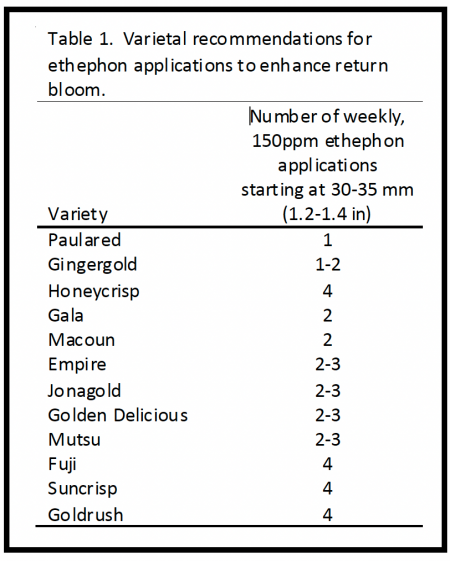
F-131R--2009: Enhancing Return Bloom of Apple
Apple flower buds are formed in June and July for most varieties. Roughly 25-30 days after full bloom is the rule of thumb for the end of the thinning window, and the beginning of the flower bud development stage. Though this is a rough guideline, actual physiological responses are a result of degree day accumulations.
In addition to utilizing the hormonal type chemical thinners (NAA, NAD, 6-Ba, ethephon) at the normal thinning windows, research has shown that both NAA and Ethephon can be also be applied in supplemental applications to enhance flower bud formation for the following season.
Beginning when king fruit are 30-35mm in diameter (roughly 4-6 weeks after bloom, depending on temperature), growers can begin using ethephon or NAA applications to stimulate return bloom.
Ethephon
Ethephon is a synthetic compound that is broken down in should begin when fruit are 30-35 mm (1.2-1.4 inches) in diameter. See Table 1 for the number of weekly appliations recommended per variety. Ethephon on non-bearing apples can be used at 300-450 ppm (1-1.5 pts/100 gallons) beginning 2-4 weeks after full bloom. However, these trees should have filled their space and be ready to bear the following year. Ethephon will reduce tree growth.
NAA
NAA can also be used for return bloom. One approach to is to use NAA when fruit reach 30-35mm in diameter (about 4- 6 weeks after bloom, depending on temperature) at 5 ppm and make repeat applications at 5 ppm at 7-day intervals. The label calls for up to 3 applications on hard-to-thin cultivars. West Coast growers have experimented with up to 5 applications. Some observations have suggest that Fruitone-L has greater activity than Fruitone-N.
Cautions
Ethephon applications at high temperatures and high rates can defruit trees, make sure you are past June drop and observe the temperature for the day of application + 2 days. NAA can reduce fruit size; this may be a concern on smallfruited cultivars.
Conclusion
Growers considering the use of PGR’s for return bloom need to be in tune with their orchard conditions before making any application. PGR’s can be very beneficial to a growers operation by breaking a biennial cycle, but their use requires a careful understanding of all parameters their application can influence. Begin slowly and follow all label rates, guidelines and precautions. The label is the law.
Note: The above information was developed from research and observations in New Jersey, other portions of the Mid Atlantic and Massachusetts fruit growing regions.
--
Issued by University of Massachusetts Extension, Nancy Garrabrants, Director, in furtherance of the acts of May 8 and June 30, 1914. University of Massachusetts Extension offers equal opportunity in programs and employment. F-131R:5/09-500
